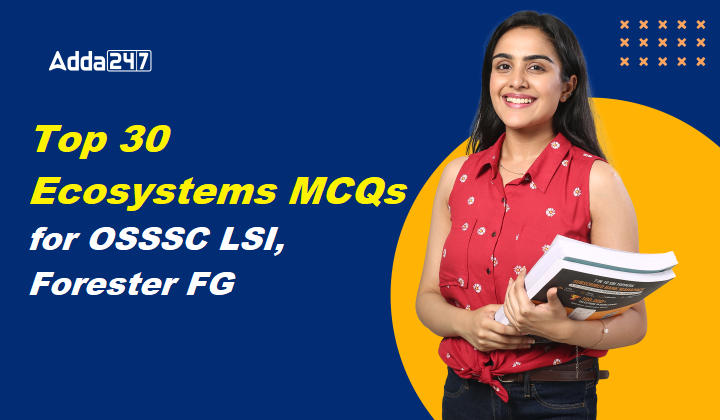Preparing for OSSSC LSI, Forester FG exams requires a comprehensive understanding of ecosystems, as they play a crucial role in sustaining life on Earth. Ecosystems are diverse and varied, ranging from terrestrial to aquatic environments, each with its unique characteristics and components. Terrestrial ecosystems include forests, grasslands, deserts, and mountains. Forest ecosystems, for instance, are vital for biodiversity and carbon sequestration, while grassland ecosystems support grazing animals and provide habitat for various species. Desert ecosystems, with their extreme dry conditions, showcase remarkable adaptations in flora and fauna, while mountain ecosystems, characterized by high altitudes and diverse climates, play a crucial role in regulating water flow and supporting unique species.
Top 30 Ecosystems MCQS For OSSSC LSI, Forester FG
In summary, a comprehensive knowledge of ecosystems is fundamental for OSSSC RI, ARI, Amin, SFS, and ICDS Supervisor exams, as it not only enriches understanding of environmental science but also highlights the interconnectedness of all living organisms and their surroundings
- What are producers in an ecosystem?
a) Animals that consume other organisms for food
b) Organisms that produce their own food using solar energy
c) Decomposers that break down dead matter
d) None of the aboveAnswer: b) Organisms that produce their own food using solar energy - Which of the following is an example of a primary consumer?
a) Lion
b) Deer
c) Snake
d) EagleAnswer: b) Deer - What do decomposers do in an ecosystem?
a) Produce food using solar energy
b) Break down dead matter into simpler substances
c) Consume other organisms for food
d) None of the aboveAnswer: b) Break down dead matter into simpler substances - Which trophic level consists of organisms that feed directly on producers?
a) Primary consumers
b) Secondary consumers
c) Tertiary consumers
d) ProducersAnswer: a) Primary consumers - What is the process called when energy is passed from one trophic level to another in a food chain?
a) Decomposition
b) Photosynthesis
c) Energy flow
d) PredationAnswer: c) Energy flow - Which of the following is NOT a biotic component of an ecosystem?
a) Producers
b) Consumers
c) Decomposers
d) SunlightAnswer: d) Sunlight - What is the role of apex predators in an ecosystem?
a) They produce food using solar energy
b) They feed directly on producers
c) They regulate the population of other organisms
d) They break down dead matter into simpler substancesAnswer: c) They regulate the population of other organisms - Which organism is classified as a secondary consumer?
a) Grasshopper
b) Rabbit
c) Snake
d) LionAnswer: d) Lion - What is the primary source of energy in most ecosystems?
a) Soil nutrients
b) Water
c) Sunlight
d) AirAnswer: c) Sunlight - Which group of organisms plays a crucial role in recycling nutrients in an ecosystem?
a) Producers
b) Consumers
c) Decomposers
d) Apex predatorsAnswer: c) Decomposers - Which of the following is NOT considered a biotic component of an ecosystem?
a) Air
b) Water
c) Soil
d) PlantsAnswer: d) Plants - What are abiotic components of an ecosystem primarily composed of?
a) Living organisms
b) Inorganic materials
c) Decomposers
d) ProducersAnswer: b) Inorganic materials - How many main types of ecosystems are based on their general environment?
a) Two
b) Three
c) Four
d) FiveAnswer: b) Three , There are three broad categories of ecosystems based on their general environment: freshwater, marine, and terrestrial. - Which of the following is NOT a type of terrestrial ecosystem?
a) Forest ecosystem
b) Ocean ecosystem
c) Desert ecosystem
d) Mountain ecosystemAnswer: b) Ocean ecosystem - Which type of ecosystem is found only on land?
a) Aquatic ecosystem
b) Forest ecosystem
c) Wetlands
d) Lotic ecosystemAnswer: b) Forest ecosystem - What are the categories of the freshwater ecosystem?
a) Lentic and desert
b) Lotic and wetlands
c) Lentic, lotic, and wetlands
d) Forest and grasslandAnswer: c) Lentic, lotic, and wetlands - Which of the following is an example of a lentic freshwater ecosystem?
a) River
b) Pond
c) Ocean
d) StreamAnswer: b) Pond - What characterizes a lotic freshwater ecosystem?
a) Slow-moving water
b) Saturated soil
c) Fast-moving water
d) Desert environmentAnswer: c) Fast-moving water - What type of ecosystem includes lakes, ponds, and pools?
a) Desert ecosystem
b) Forest ecosystem
c) Lentic freshwater ecosystem
d) WetlandsAnswer: c) Lentic freshwater ecosystem - Where are wetlands typically found?
a) In high mountain regions
b) In grasslands
c) In areas with saturated soil and water
d) In desert environmentsAnswer: c) In areas with saturated soil and water - Which of the following is NOT a type of terrestrial ecosystem?
a) Forest
b) Desert
c) Grassland
d) OceanAnswer: d) Ocean - Which of the following ecosystems are found only on landforms?
a) Terrestrial ecosystems
b) Aquatic ecosystems
c) Forest ecosystems
d) Desert ecosystemsAnswer: a) Terrestrial ecosystems - What does an ecological pyramid represent?
a) The relationship between different ecosystems
b) The relationship between different trophic levels
c) The relationship between biotic and abiotic factors
d) The relationship between different species in an ecosystemAnswer: b) The relationship between different trophic levels - Which type of ecological pyramid represents the total mass of organisms at each trophic level?
a) Pyramid of Numbers
b) Pyramid of Biomass
c) Pyramid of Productivity
d) Pyramid of Succession - Answer: b) Pyramid of BiomassWhat is primary succession?
a) Succession in which an ecosystem that is destroyed revives itself
b) Succession in which plants and animals first colonize a barren piece of land
c) Succession in which pioneer species establish themselves in an area
d) Succession in which climax community is establishedAnswer: b) Succession in which plants and animals first colonize a barren piece of land
- What is the function of autotrophs in an ecosystem?
a) Regulate the flow of energy
b) Cycle minerals through the biosphere
c) Produce energy transferred through trophic levels
d) Provide stability to the ecosystemAnswer: c) Produce energy transferred through trophic levels - What is nutrient cycling?
a) The process of recycling minerals in the biosphere
b) The process of energy flow through different trophic levels
c) The process of photosynthesis by autotrophs
d) The process of succession in an ecosystemAnswer: a) The process of recycling minerals in the biosphere - Which type of succession occurs after an ecosystem is destroyed and then revives itself?
a) Primary Succession
b) Secondary Succession
c) Tertiary Succession
d) Quaternary SuccessionAnswer: b) Secondary Succession - What is an ecosystem?
a) An area where only plants and animals coexist
b) A bubble of life formed by living organisms, weather, and landscape
c) A specific habitat for plants and animals
d) A confined area where only abiotic factors interactAnswer: b) A bubble of life formed by living organisms, weather, and landscape - What is the main difference between biotic and abiotic factors?
a) Biotic factors are living components, while abiotic factors are non-living components
b) Biotic factors are non-living components, while abiotic factors are living components
c) Biotic factors include weather and landscape, while abiotic factors include plants and animals
d) There is no difference between biotic and abiotic factorsAnswer: a) Biotic factors are living components, while abiotic factors are non-living component





